Java for Python Programmers
Bradley N. Miller
January 27, 2008
1
�
1 Preface
Welcome to Java for Python Programmers. This short ebook is an ongoing project to help Computer
Science students who have had one or two semesters of Python learn the Java programming language.
If you are not a part of that audience you may still find this a useful way to learn about Java. This
book is written using the build on what you know philosophy. In order to help you learn Java I
will start with a Python example and then implement the example in Java. Along the way we will
examine the strengths, weaknesses and differences between those two languages.
This book does not attempt to replace the many good Java reference books that are available, in
fact I use this in my course along with Horstman’s Core Java volumes. Please feel free to use this
book for yourself, or if it fits a class you are teaching you are welcome to use this as a resource for
your own class.
I have published this article using a Creative Commons license to encourage you to use it, change
it, and modify it for your own purposes. I would appreciate knowing what you think if you do use
this book, and I would love to see any modifications or additions you make.
Brad Miller bmiller@luther.edu January, 2008
This work is licensed under a Creative Commons Attribution 3.0 United States License. See
http://creativecommons.org
2
�
Contents
1 Preface
2 Introduction
3 Why Learn another programming Language?
4 Why Learn Java? Why not C or C++?
4.1 Lets look at a Java Program . . . . . . . . . . . . . . . . . . . . . . . . . . . . . . . .
5 Java Data Types
5.1 Numeric . . . . . . . . . . . . . . . . . . . . . . . . . . . . . . . . . . . . . . . . . . .
5.1.1
Import . . . . . . . . . . . . . . . . . . . . . . . . . . . . . . . . . . . . . . . .
5.1.2 Declaring Variables . . . . . . . . . . . . . . . . . . . . . . . . . . . . . . . . .
Input / Output / Scanner . . . . . . . . . . . . . . . . . . . . . . . . . . . . .
5.1.3
5.2 String . . . . . . . . . . . . . . . . . . . . . . . . . . . . . . . . . . . . . . . . . . . .
5.3 List
. . . . . . . . . . . . . . . . . . . . . . . . . . . . . . . . . . . . . . . . . . . . .
5.4 Arrays . . . . . . . . . . . . . . . . . . . . . . . . . . . . . . . . . . . . . . . . . . . .
5.5 Dictionary . . . . . . . . . . . . . . . . . . . . . . . . . . . . . . . . . . . . . . . . . .
6 Conditionals
6.1 Simple if . . . . . . . . . . . . . . . . . . . . . . . . . . . . . . . . . . . . . . . . . . .
6.2
. . . . . . . . . . . . . . . . . . . . . . . . . . . . . . . . . . . . . . . . . . . .
if else
elif . . . . . . . . . . . . . . . . . . . . . . . . . . . . . . . . . . . . . . . . . . . . . .
6.3
7 Loops and Iteration
7.1 Definite Loop . . . . . . . . . . . . . . . . . . . . . . . . . . . . . . . . . . . . . . . .
Indefinite Loops . . . . . . . . . . . . . . . . . . . . . . . . . . . . . . . . . . . . . . .
7.2
8 Defining Classes in Java
8.1 Writing a constructor
8.2 Methods or Member Functions
8.3
. . . . . . . . . . . . . . . . . . . . . . . . . . . . . . . . . . .
. . . . . . . . . . . . . . . . . . . . . . . . . . . . . .
8.2.1 Method Signatures and Overloading . . . . . . . . . . . . . . . . . . . . . . .
Inheritance . . . . . . . . . . . . . . . . . . . . . . . . . . . . . . . . . . . . . . . . .
. . . . . . . . . . . . . . . . . . . . . . . . . . . . . . . . .
8.3.1 The Object Class
8.3.2 Abstract Classes and Methods
. . . . . . . . . . . . . . . . . . . . . . . . . .
8.4
. . . . . . . . . . . . . . . . . . . . . . . . . . . . . . . . . . . . . . . . . .
Interfaces
8.5 Static member variables . . . . . . . . . . . . . . . . . . . . . . . . . . . . . . . . . .
8.6 Static Methods . . . . . . . . . . . . . . . . . . . . . . . . . . . . . . . . . . . . . . .
8.7 Full Implementation of the Fraction Class . . . . . . . . . . . . . . . . . . . . . . . .
9 Common Mistakes
3
2
5
5
6
6
9
9
10
11
12
13
13
16
17
18
18
19
19
21
21
22
23
25
25
26
28
28
29
30
32
32
33
35
�
10 Naming Conventions
11 Java Documentation Online
12 Colophon
13 Shameless Plug
35
36
36
36
4
�
2
Introduction
This book assumes that you are already familiar with the Python programming language. We will
use Python as a starting point for our journey into Java. We will begin by looking at a very simple
Java program, just to see what the language looks like and how we get a program to run. Next, we
will look at the main constructs that are common to most programming languages:
• Data Types
• Loops
• Reading user input
• Conditionals
Once we have the basics of Java behind us we will move on to look at the features of Java that are
both unique and powerful.
• Classes
• Interfaces
• Collections
• Graphical User Interface Programming
• Generic Programming
Please note that this book is a work in progress. I will continue to update and post new versions.
3 Why Learn another programming Language?
Python is a nice language for beginning programming for several reasons. First the syntax is sparse,
and clear. Second, the underlying model of how objects and variables work is very consistent.
Third, you can write powerful and interesting programs without a lot of work. However, Python is
representative of one kind of language, called a dynamic language. You might think of Python as
being fairly informal. There are other languages, Like Java and C++ that are more formal.
These languages have some advantages of their own. First, is speed: For very large programs Java
and C++ are going to give you the best performance. Second is their maintainability. A lot of what
makes Python easy to use is that you must remember certain things. For example if you set variable
x to reference a turtle, and forget later that x is a turtle but try to invoke a string method on it,
you will get an error. Java and C++ protect you by forcing you to be upfront and formal about the
kind of object each variable is going to refer to.
In one sense Python is representative of a whole class of languages, sometimes referred to as “script-
ing languages.” Other languages in the same category as Python are Ruby and Perl. Java is
representative of what I will call industrial strength languages. Industrial strength languages are
good for projects with several people working on the project where being formal and careful about
what you do may impact lots of other people. Languages in this category include C++, C, C# and
Ada.
Programming languages will always change. As the field of computer science advances there will
be new programming languages and you will need to learn them. It is important to learn several
programming languages so that you know what to expect. There are certain features that most
programming languages have in common; variables, loops, conditionals, functions. And there are
some features that are unique. If you know what is common in languages that is a good place to
start.
5
�
4 Why Learn Java? Why not C or C++?
• Java is the most widely taught programming language.
• Java is more popular
• Java is industrial strength used for large systems by large groups of people
• If you know Java learning C++ is easy.
Java is an enormous language. There are over 3700 different classes included in the Java 6 Standard
Edition. We could not begin to scratch the surface of these classes even if we devoted all 2700
minutes of class time that we have in a semester. However Java is very powerful and we will write
some very powerful programs this semester.
4.1 Lets look at a Java Program
A time honored tradition in Computer Science is to write a program called “hello world.” The “hello
world” program is simple and easy. There are no logic errors to make, so getting it to run relies
only on understanding the syntax. To be clear lets look a a “complicated” version of hello world for
Python:
1 def main ():
2
print " Hello World ! "
Remember that we can define this program right at the Python command line and then run it:
>>> main()
"Hello World!"
>>>
Now lets look at the same program written in Java:
1 public c l a s s Hello {
2
3
4
5
6
7
}
}
public s t a t i c void main ( String [] args ) {
System . out . println ( " Hello World ! " );
What we see is that at the core there are a few similarities, such as a main and the string “Hello
World” However there is a lot more stuff around the edges that make it harder to see the core of
the program. Do not worry! An important skill for a computer scientist is to learn what to ignore
and what to look at carefully. You will soon find that there are some elements of Java that will fade
into the background as you become used to seeing them. One thing that will help you is to learn a
little bit about Java Naming Conventions.
The first question you probably have about this little program is “How do I run it?” Running a
Java program is not as simple as running a Python program. The first thing you need to do with a
Java program is compile it. The first big difference between Java and Python is that Python is an
interpreted language. We could run our Python programs in the Python interpreter and we were
quite happy to do that. Java makes running programs a two step process. First we must type the
hello world program into a file and save that file using the name Hello.java The file name must be
the same as the public class you define in the file. Once we have saved the file we compile it from
the command line as follows:
6
�
$ javac Hello.java
$ ls -l Hello.*
-rw-r--r--
-rw-r--r--
1 bmiller bmiller
1 bmiller bmiller
391 Jul 19 17:47 Hello.class
117 Jul 19 17:46 Hello.java
The command javac compiles our java source code into compiled byte code and saves it in a file
called Hello.class. Hello.class is a binary file so you won’t learn much if you try to examine
the class file with an editor. Hopefully you didn’t make any mistakes, but if you did you may want
to consult the Common Mistakes section for helpful hints on compiler errors.
Now that we have compiled our java source code we can run the compiled code using the java
command.
$ java Hello
Hello World!
$
Now you may be wondering what good is that extra step? What does compiling do for us? There
are a couple of important benefits we get from compiling:
• Early detection of errors
• Faster Program Execution
The job of the compiler is to turn your java code into language that the Java Virtual Machine (JVM)
can understand. We call the code that the JVM understands byte code. The JVM interprets the
byte code much like the Python interpreter interprets your Python. However since byte code is
much closer to the native language of the computer it can run faster.
When the compiler does the translation it can find many different kinds of errors. For example if
you make a typo the compiler will find the typo and point it out to you before you ever run the
program. We will look at some examples of compiler errors shortly. Chances are you will create
some on your own very soon too.
Now that we have run our hello world program, lets go back and look at it carefully to see what we
can learn about the Java language. This simple example illustrates a few very important rules:
1. Every Java program must define a class, all code is inside a class.
2. Everything in Java must have a type
3. Every Java program must have a function called public static void main(String[] args)
Lets take the hello world example a line at a time to see how these rules are applied. On line 1 we
see that we are declaring a class called Hello. As rule 1 says all Java code resides inside a class.
Unlike Python where a program can simply be a bunch of statements in a file, Java programs must
be inside a class. So, we define a class, Hello is not a very useful class it has no instance variables,
and only one method. You will also notice the curly brace { In Java blocks of code are identified by
pairs of curly braces. The block starts with a { and ends with a }. You will notice that I indented
my code that followed the left brace, but in Java this is only done by convention it is not enforced.
On the next line we start our method definition. The name of this method is:
public static void main(String[] args)!
Everything on this line is significant, and helps in the identification of this method. For example
the following lines look similar but are in fact treated by Java as completely different methods:
7
�
• public void main(String[] args)
• public static void main(String args)
• public static void main()
• void main(String args)
Just digging in to this one line will take us deep into the world of Java, so we are going to start
digging but we are not going to dig too deeply right away. Much of what could be revealed by this
one line is better understood through other examples, so be patient.
The first word, public indicates to the Java compiler that this is a method that anyone can call.
We will see that Java enforces several levels of security on the methods we write, including public,
protected, and private methods.
The next word, static tells Java that this is a method that is part of the class, but is not a method
for any one instance of the class. The kind of methods we typically wrote in Python required an
instance in order for the method to be called. With a static method, the object to the left of the . is a
class, not an instance of the class. For example the way that we would call the main method directly
is: Hello.main(parameter1). For now you can think of static methods the same way you think of
methods in Python modules that don’t require an instance, for example the math module contains
many methods: sin, cos, etc. You probably evaluated these methods using the names math.cos(90)
or math.sin(60).
The next word, void tells the Java compiler that the method main will not return a value. This is
roughly analogous to omitting the return statement in a Python method. In other words the method
will run to completion and exit but will not return a value that you can use in an assignment
statement. As we look at other examples we will see that every Python function must tell the
compiler what kind of an object it will return. This is in keeping with the rule that says everything
in Java must have a type. In this case we use the special type called void which means no type.
Next we have the proper name for the method: main. The rules for names in Java are similar to the
rules in Python. Names can include letters, numbers, and the _. Names in Java must start with a
letter.
Finally we have the parameter list for the method. In this example we have one parameter. The
name of the parameter is args however, because everything in Java must have a type we also have
to tell the compiler that the value of args is an array of strings. For the moment You can just think
of an array as being the same thing as a list in Python. The practical benefit of declaring that the
method main must accept one parameter and the parameter must be a an array of strings is that
if you call main somewhere else in your code and and pass it an array of integers or even a single
string, the compiler will flag it as an error.
That is a lot of new material to digest in only a single line of Java. Lets press on and look at the
next line: System.out.println("Hello World!");. This line should look a bit more familiar to
you. Python and Java both use the dot notation for finding names. In this example we start with
System. System is a class. Within the system class we find the object named out. The out object
is the standard output stream for this program. Having located the out object Java will now call
the method named println(String s) on that object. The println method prints a string and
adds a newline character at the end. Anywhere in Python that you used the print function you
will use the System.out.println method in Java.
Now there is one more character on this line that is significant and that is the ; at the end. In Java
the ; signifies the end of a statement. Unlike Python where statements are almost always only one
line long java statements can spread across many lines. The compiler knows it has reached the end
of a statement when it encounters a ;. This is a very important difference to remember. In Java
the following statements are all legal and equivalent. I would not encourage you to write your code
like this, but you should know that it is legal.
System.out.println("Hello World");
System.out.println("Hello World")
8
�
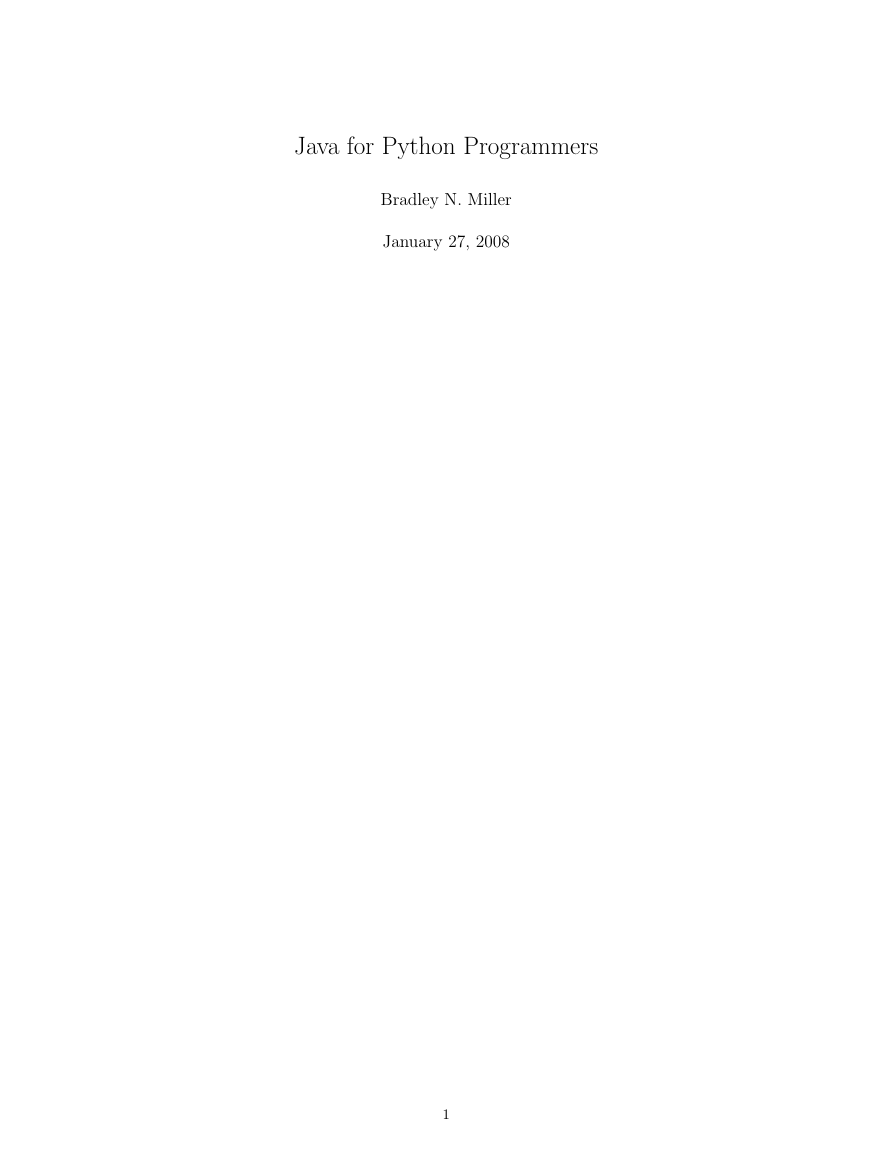
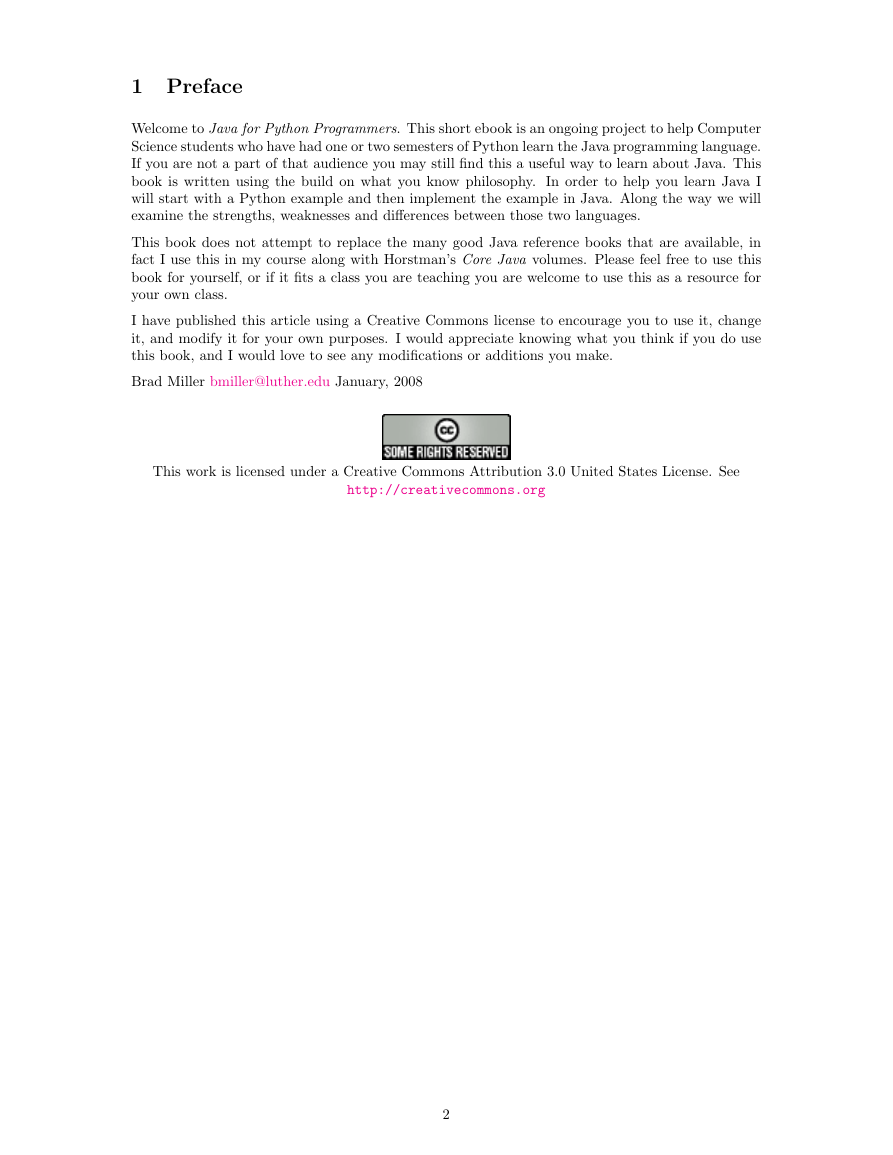
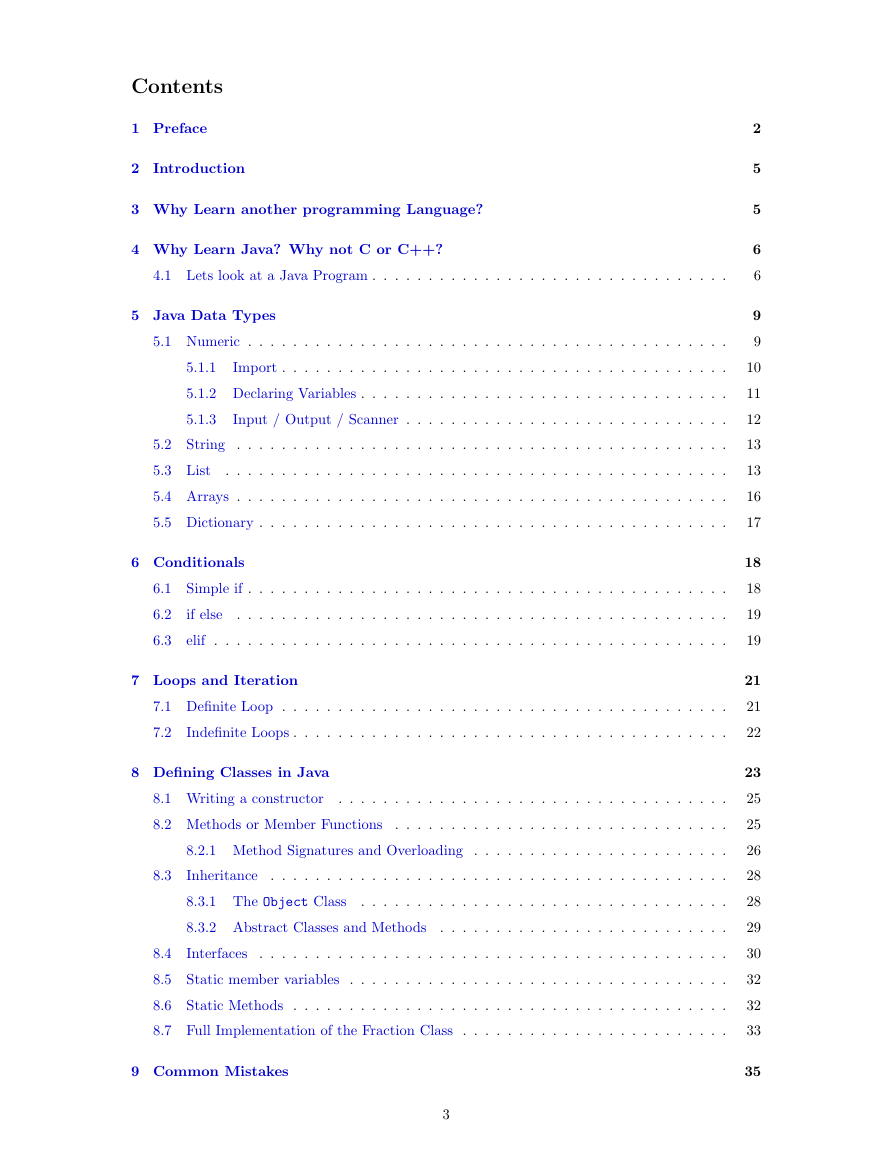

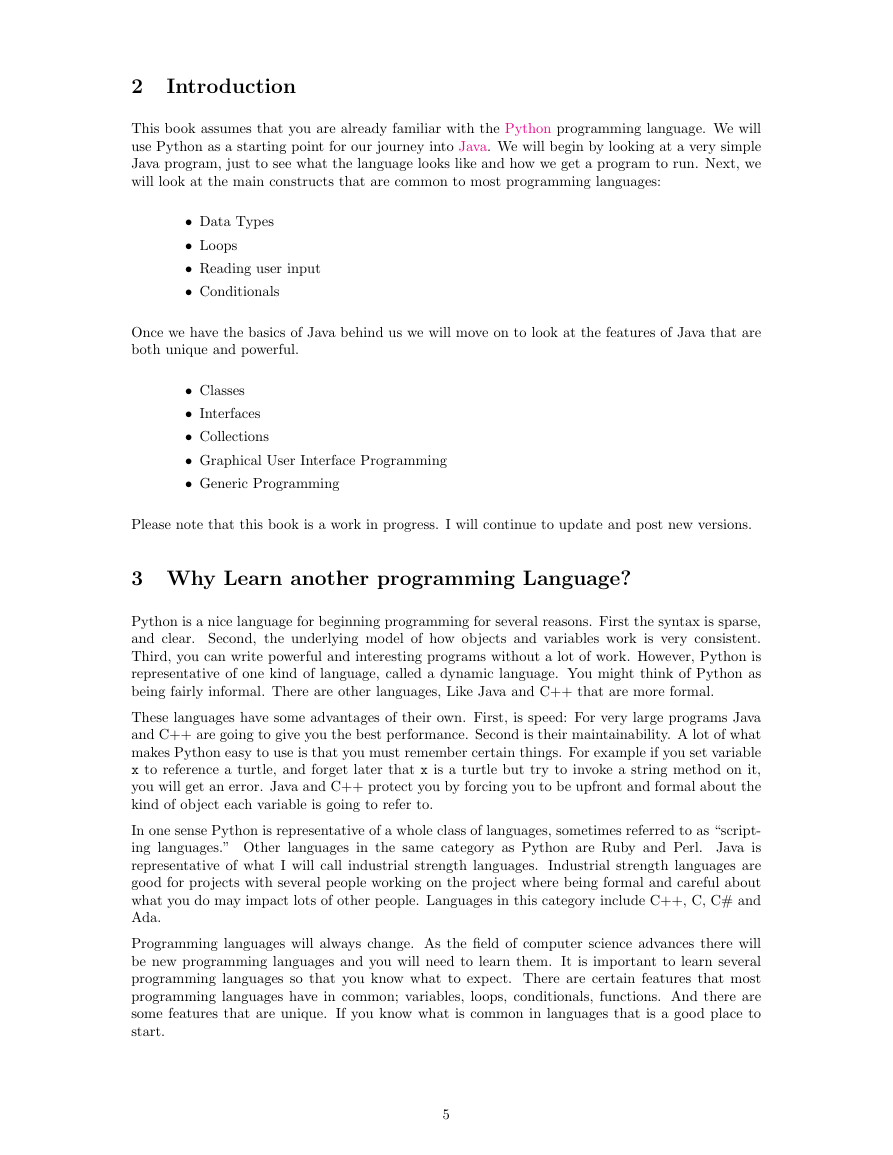
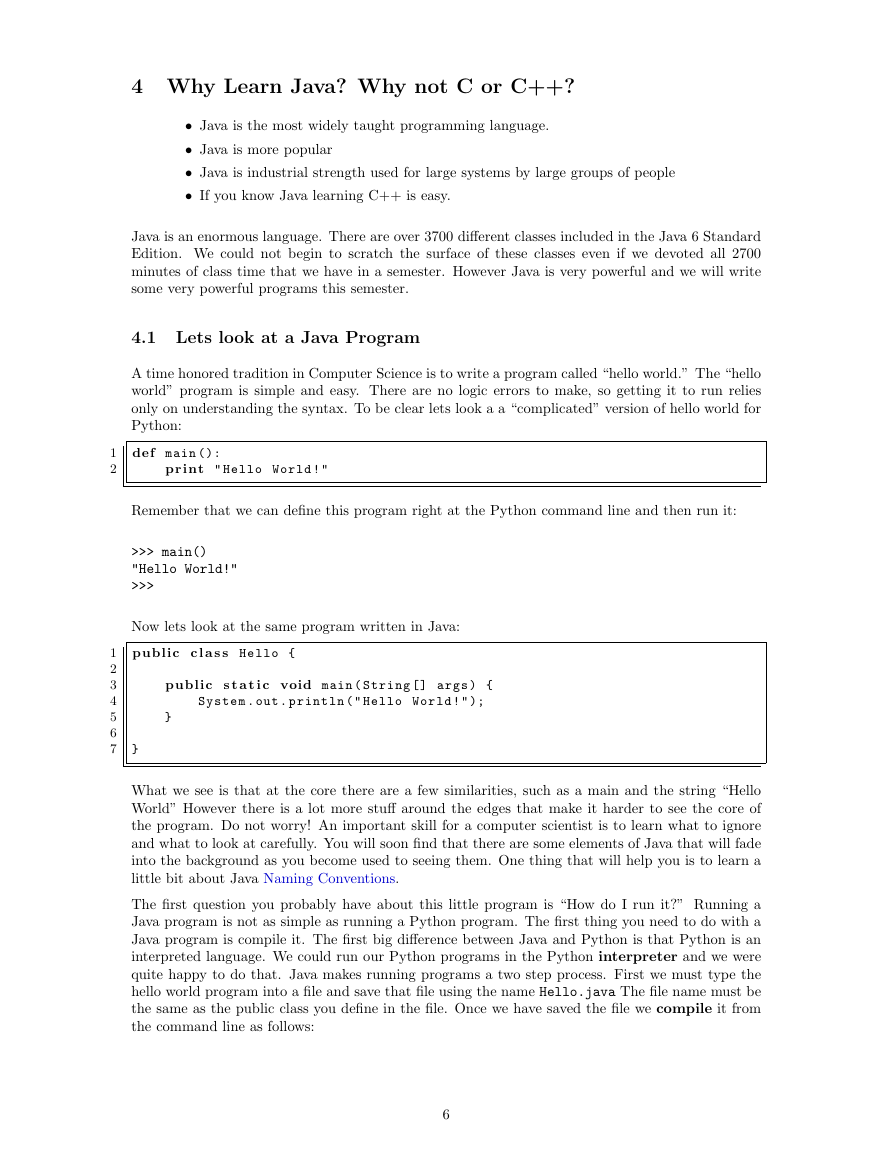
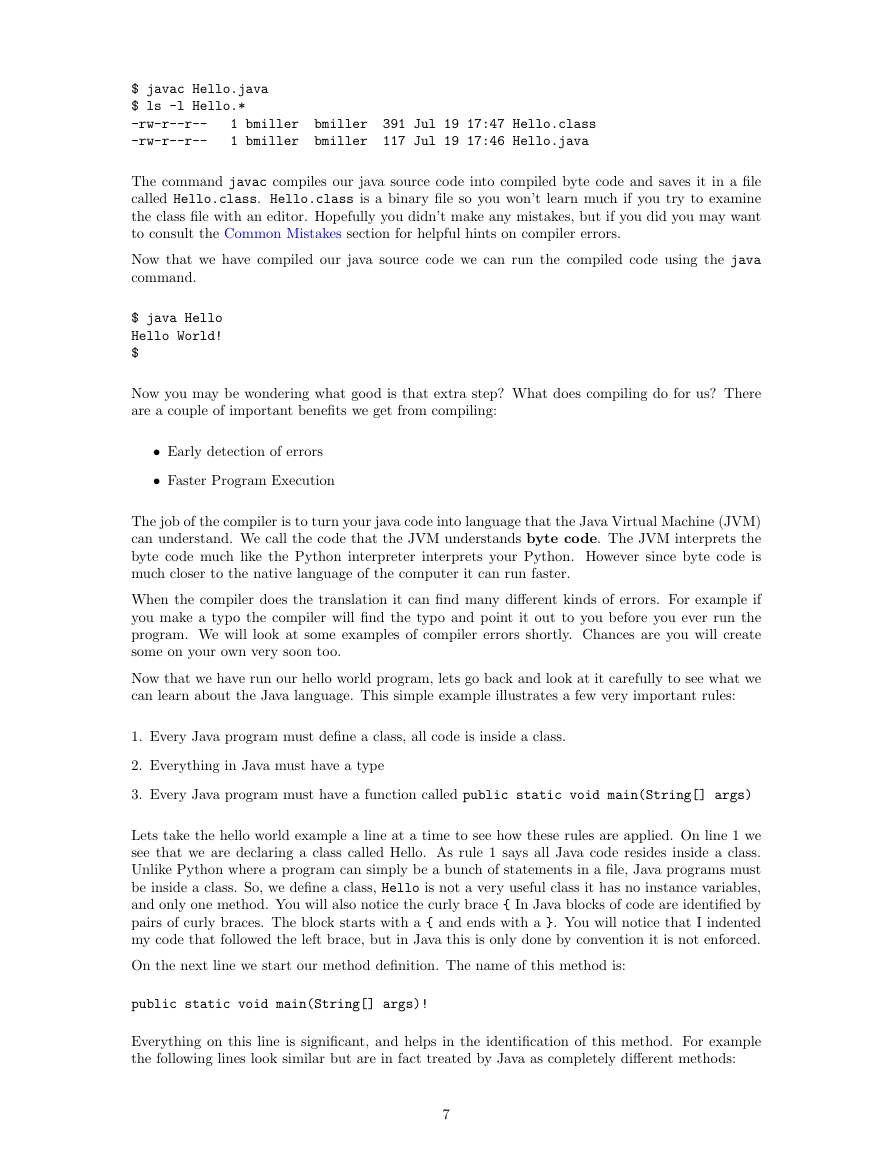
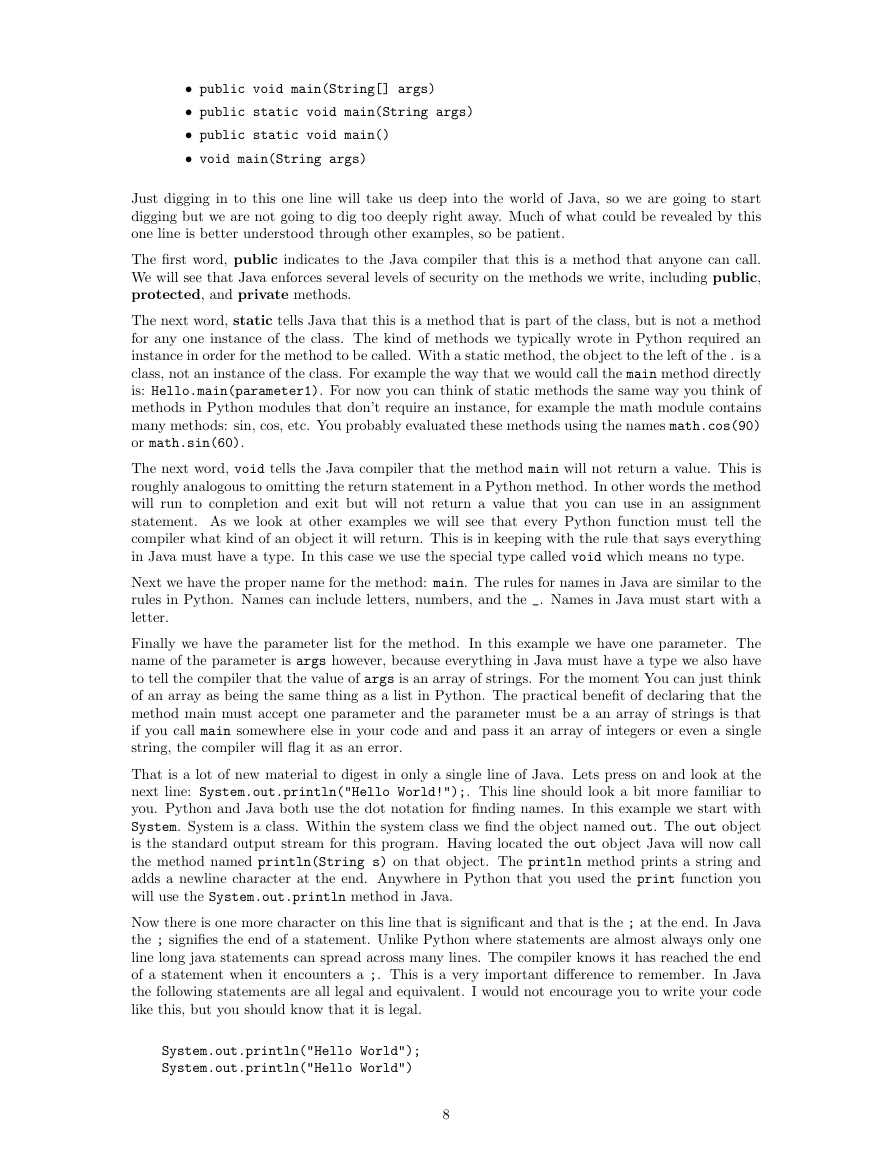








 2023年江西萍乡中考道德与法治真题及答案.doc
2023年江西萍乡中考道德与法治真题及答案.doc 2012年重庆南川中考生物真题及答案.doc
2012年重庆南川中考生物真题及答案.doc 2013年江西师范大学地理学综合及文艺理论基础考研真题.doc
2013年江西师范大学地理学综合及文艺理论基础考研真题.doc 2020年四川甘孜小升初语文真题及答案I卷.doc
2020年四川甘孜小升初语文真题及答案I卷.doc 2020年注册岩土工程师专业基础考试真题及答案.doc
2020年注册岩土工程师专业基础考试真题及答案.doc 2023-2024学年福建省厦门市九年级上学期数学月考试题及答案.doc
2023-2024学年福建省厦门市九年级上学期数学月考试题及答案.doc 2021-2022学年辽宁省沈阳市大东区九年级上学期语文期末试题及答案.doc
2021-2022学年辽宁省沈阳市大东区九年级上学期语文期末试题及答案.doc 2022-2023学年北京东城区初三第一学期物理期末试卷及答案.doc
2022-2023学年北京东城区初三第一学期物理期末试卷及答案.doc 2018上半年江西教师资格初中地理学科知识与教学能力真题及答案.doc
2018上半年江西教师资格初中地理学科知识与教学能力真题及答案.doc 2012年河北国家公务员申论考试真题及答案-省级.doc
2012年河北国家公务员申论考试真题及答案-省级.doc 2020-2021学年江苏省扬州市江都区邵樊片九年级上学期数学第一次质量检测试题及答案.doc
2020-2021学年江苏省扬州市江都区邵樊片九年级上学期数学第一次质量检测试题及答案.doc 2022下半年黑龙江教师资格证中学综合素质真题及答案.doc
2022下半年黑龙江教师资格证中学综合素质真题及答案.doc